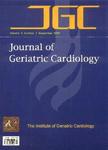Value of a comprehensive geriatric assessment for predicting one-year outcomes in patients undergoing transcatheter aortic valve implantation: results from the CGA-TAVI multicentre registry
Value of a comprehensive geriatric assessment for predicting one-year outcomes in patients undergoing transcatheter aortic valve implantation: results from the CGA-TAVI multicentre registry作者机构:Department of Cardiology Amsterdam UMC University of Amsterdam Department of Internal Medicine Section of Geriatric Medicine Amsterdam UMC University of Amsterdam Geriatric Intensive Care Unit Department of Geriatrics and Medicine Careggi Hospital and University of Florence Centre Hospitalier de l’Université de Montréal Edwards Lifesciences Edwards Lifesciences Nyon Switzerland Institute for Pharmacology und Preventive Medicine Department of Geriatrics Inselspital Bern University Hospital University of Bern Switzerland
出 版 物:《Journal of Geriatric Cardiology》 (老年心脏病学杂志(英文版))
年 卷 期:2019年第16卷第6期
页 面:468-477页
核心收录:
基 金:provided by Edwards Lifesciences (Nyon, Switzerland) to the Sponsor IPPMed (Cloppenburg, Germany) funding from Edwards Lifesciences as did Andrea Ungar
主 题:Comprehensive geriatric assessment Multidimensional prognostic index Short physical performance battery Silver code Transcatheter aortic valve implantation
摘 要:Background In a three-month report from the CGA-TAVI registry, we found the Multidimensional Prognostic Index (MPI) and Short Physical Performance Battery (SPPB) to be of value for predicting short-term outcomes in elderly patients undergoing transcatheter aortic valve implantation (TAVI). In the present analysis, we examined the association of these tools with outcomes up to one year post-TAVI. Methods CGA-TAVI is an international, observational registry of geriatric patients undergoing TAVI. Patients were assessed using the MPI and SPPB. Efficacy of baseline values and any postoperative change for predicting outcome were established using logistic regression. Kaplan- Meier analysis was carried out for each comprehensive geriatric assessment tool, with survival stratified by risk category. Results One year after TAVI, 14.1% of patients deceased, while 17.4% met the combined endpoint of death and/or non-fatal stroke, and 37.7% the combined endpoint of death and/or hospitalisation and/or non-fatal stroke. A high-risk MPI score was associated with an increased risk of all-cause mortality (aOR = 36.13, 95% CI: 2.77–470.78, P = 0.006) and death and/or non-fatal stroke (aOR = 10.10, 95% CI: 1.48–68.75, P = 0.018). No significant associations were found between a high-risk SPPB score and mortality or two main combined endpoints. In contrast to a worsening SPPB, an aggravating MPI score at three months post-TAVI was associated with an increased risk of death and/or non-fatal stoke at one year (aOR = 95.16, 95% CI: 3.41–2657.01). Conclusions The MPI showed value for predicting the likelihood of death and a combination of death and/or non-fatal stroke by one year after TAVI in elderly patients.



